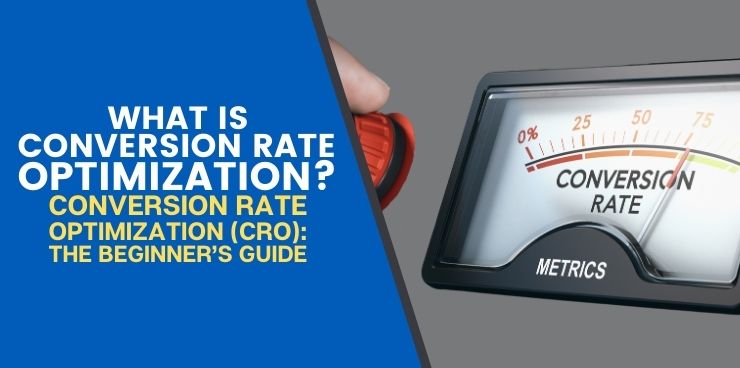A steady source of new customers allows a business to grow. Many businesses use marketing materials to attract these new customers and increase revenue. However, not all sales leads become sales prospects.
The conversion rate measures the effectiveness of a marketing campaign by finding the percentage of leads who buy the product. Businesses can improve their conversion rates through a practice called conversion rate optimization (CRO).
A well-implemented CRO program can increase the success of a marketing campaign. Without a proper CRO strategy, even the best campaigns will fall short. Known as CRO marketing, these practices work in conjunction with each other to create the best effect.
What is Conversion Rate Optimization (CRO)?
Conversion rate optimization increases the likelihood of a sales lead taking the desired action. It includes all practices that increase the conversion rate. CRO usually refers to how leads and potential customers interact with a business’s website.
The desired action varies depending on the business’ intentions. It could mean signing up for an email list. Many times the desired action revolves around the lead making a purchase and becoming a customer.
How do Websites Benefit From CRO?
Since the desired action often takes place on a website, this format benefits the most from CRO. Benefits specifically include:
Higher Return on Investment
Marketing efforts can take a sizable bite out of your budget. Most businesses consider their marketing expenditure as an investment. Since marketing intends to attract new customers, it expects to result in some sort of return on investment. Conversion rate optimization gets the most out of that investment.
By capitalizing on a lead’s existing interest, CRO ends up saving your business money. Instead of spending exorbitant amounts trying to get new customers, you set existing campaigns up for success. You do not need to cast a larger net, just focus on getting the fish into your boat.
Improved User Experience
A functioning website makes up one of the most important CRO tools. No matter how enticing or exciting your advertisement, you will never make a sale when leads cannot navigate your website. You need to eliminate as much friction as possible between leads and your desired action.
Make sure all links work and lead to the right page. Add a landing page that makes sense and keeps in line with your advertisement. When you focus on these small aspects, customers enjoy using your website and will come back for more purchases.
Improved Customer Insights
CRO helps you get the right customers you want for your business. Instead of wasting resources on customers unlikely to buy, CRO helps pinpoint only high-quality customers. When you focus on your target group instead of going for a mass appeal you make more sales. Customers want to feel focused on, and CRO delivers that and more.
Better Scalability
An ineffective conversion method leads to the depletion of potential new customers. CRO helps your business scale up by turning your lead pool into customers. This means you will not run out of leads as you continue to grow.
Building Trust
In the age of scams and phishing schemes, customer trust means everything. Before a customer takes that desired action and shares information you need to earn their trust. Conversion rate optimization helps you create an appealing and trustworthy website. This way, you do not miss out on a sales opportunity due to a sketchy website design.
How to Calculate Conversion Rate
Before implementing CRO, you need to find your initial conversion rate. This allows you to measure your progress. A baseline gives you insights on what works and what still needs improvement.
To get the most out of CRO, you need to implement the following three calculations:
Conversion Rate
The number around which CRO revolves, conversion rate acts as a baseline to measure success. You need to know how many leads you generate and your volume of website traffic. The conversion rate formula looks like this:
(Leads Generated ÷ Website Traffic) x 100 = Conversion Rate Percentage.
For example, when you generate 100 leads and 20 customers visit your store, your conversion rate is 20 percent.
Number of Net New Customers
You can find your specific number of new customers using the following formula:
Net Revenue Goal ÷ Average Sales Price = Number of New Customers.
With a revenue goal of $300 and an average sales price of $12, you need 25 new customers.
Lead Goal
Finally, you want to find your lead goal. This number determines how many leads you should aim to attract. You find it by dividing your number of new customers by your lead-to-customer close-rate percentage. Divide the number of leads by the number of customers to find the lead-to-customer close rate. The lead goal formula looks like this:
Number of New Customers ÷ Lead-to-Customer Close Rate % = Lead Goal
Proven Successful CRO Methods
The right CRO method varies depending on your business’s needs. The following two CRO methods can help you develop a working and effective conversion rate. Instead of just shooting in the dark, these methods offer tried-and-true techniques. To find the right one, consider your situation and which method better fits that mold.
When one method fails you can always try the other one.
Quantitative Data Analysis Method
This method delivers hard data for your team to work with. Also called the Analytics Method, it shows you data on the actions visitors take on your website.
To use this method you need a web analytics platform. Many businesses use Google Analytics. Then, adding tracking to your conversions to collect data.
In addition to visitor behavior, this method provides you with a plethora of additional information. This includes a visitor’s entry point so you know which advertisement drew their attention. It shows you who visits your website and where exactly they lose interest. It can even show you the platform customers use to visit your site, such as their PC or mobile device.
For businesses wishing to get hard data, the quantitative data analysis method will deliver plenty of that.
The People-Focused Method
Also known as the qualitative method, this method offers more focused and specific insight into a visitor’s actions. While analytical trackers find information from all visitors, the people-focused method asks them questions directly. Through sources such as surveys and questionnaires, the visitors themselves explain their actions.
Of course, this method requires the direct participation of visitors. They need to go out of their way to answer your questions. Putting a small reward for supplying their input sweetens the deal in your favor. You can offer discounts or vouchers in your store or give them a free sample.
The qualitative method comes with several advantages over the quantitative, data-driven method. It can tell you what in your advertisements drew their attention to click on your website links. You can ask what makes your product or service stand out. You can even find out where visitors think you can improve.
The open-ended nature of this method really allows you to customize it as appropriate. This takes more time of course, but the results might just make the process worthwhile.
Combining the two methods will give you as detailed a picture as possible. Quantitative tricks what visitors do and qualitative tells you why they do it. Each method complements the other and gives you a full idea of your situation. Once you gather this information, you can go about improving your conversion rates.
 Useful Tools to Improve CRO Methods
Useful Tools to Improve CRO Methods
Now that you know the ins and outs of visitor behavior, you can start adjusting your techniques. The three types of CRO tools will help you figure out what works to convert more visitors. They include:
Web Analytics CRO Tools
Web analytics tools deliver quantitative data. They track additional information such as where a visitor goes on your website. You can see the paths they take that lead them to your store. You can also see what makes them lose interest so that you can make the right changes.
Behavior Analytics CRO Tools
These tools help you collect qualitative data and then track where it applies. Instead of a jumbled mess of information, these tools sort it out. So when several visitors mention your landing page you can find their responses quickly.
CRO Testing Tools
Testing tools allow you to visualize and measure improvement. In many kinds of A/B testing, you can find the more appealing website design of two choices. With many testing tools, participants do not even know they are being tested. This helps provide more organic results.
Specific CRO tools include some of the following:
- Google Analytics: The golden egg of qualitative analytics, this tool forms the basis of any data-driven CRO method. Most websites allow for Google Analytics to function seamlessly. All website owners should start out Google Analytics in some capacity due to its convenience.
Google Analytics is free to use for all website owners. However, you can upgrade to Google Analytics 360 for recording information beyond 10 million monthly visitors.
- Adobe Analytics: This tool extends beyond just your website. It tracks data in real-time across multiple channel sources, such as apps and email marketing. You can use Adobe to analyze KPIs and directly monitor conversion rates. It offers easily understandable reports on all information.
- Heap: This tool gives real-time data on a visitor’s actions on your website and application. It works best for tracking page views and session times/amounts. It paints a good picture of how people interact and visit your website. Heap also tracks form submissions and clicks to get more data.
- Hotjar: In the behavior analytics group, Hotjar shows user behavior and pairs it with feedback. It tracks where visitors go which shows you what works and what fails in your website design. Plus, it includes on-site surveys so that you can get a more thorough understanding of your visitor’s thought process.
- Crazy Egg: This heatmap and the testing tool allow you to collect and rate data. It also gives you the ability to directly test any changes you make. This makes tweaking your website a breeze. When you can see how a customer reacts to a change, you can immediately determine its success.
- Moz Pro: You can combine Moz Pro with your existing Google Analytics profile to get custom reports. This helps you sort through tons of incoming data without getting overwhelmed. Moz includes recommendations to help you make the proper adjustments to your website. This way, you do not have to go through your optimization process alone.
- Google Consumer Surveys: Another notch for the people-focused method, Google does the legwork of finding participants. All you have to worry about is creating the specific survey you need. This allows for greater flexibility and customization. Google then gets you results by getting your surveys out there for participants to take part in.
- Qualaroo: This tool allows you to poll active visitors through a little pop-up window.
- Usertesting.com: Before you launch a website, use Usertesting to get participants to try it out. This way, you have some unbiased opinions on user-friendliness prior to launch.
- Inspeclet: This tool shows you recorded sessions of an actual visitor interacting with your website.
- Optimizely: Great for A/B testing, Optimizely helps you set up a test on already existing websites.
- Unbounce: A tool for creating and testing new pages, Unbounce streamlines your optimization process.
- Google Content Experiments: Another add-on to your Google Analytics, this tool lets you perform A/B testing compared to your desired outcome.
Implementing Optimization
Getting sales leads all the way through the sales funnel takes time and finesse. As your industry evolves, attracting new customers can start to feel overwhelming. Thankfully, Selling Revolution can help. We help our clients increase their leads and refine their sales processes. So, when you need help finding your CRO best practices, you can count on our professional consultation.
Start your journey today by scheduling a 20-minute introductory call.




 Useful Tools to Improve CRO Methods
Useful Tools to Improve CRO Methods